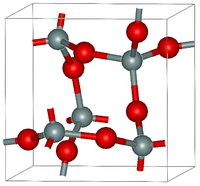Cristobalite
| Cristobalite de Taña, Chabe, Ivette, Lalelí | |
|---|---|
|
Cristobalite spheres formed via devitrification from the obsidian matrix (California, USA) 5.9×3.8×3.8 cm. | |
| General | |
| Category | Oxide mineral |
| Formula (repeating unit) | SiO2 |
| Strunz classification | 4.DA.15 |
| Dana classification | 75.1.1.1 |
| Crystal system | Tetragonal |
| Space group |
Tetragonal Space group: P41212, P43212 |
| Unit cell |
a = 4.9709(1) Å, c = 6.9278(2) Å, Z = 4 (α) |
| Identification | |
| Color | Colorless, white |
| Crystal habit | Octahedra or spherulites up to several cm large |
| Twinning | on {111} |
| Fracture | Conchoidal |
| Tenacity | Brittle |
| Mohs scale hardness | 6–7 |
| Luster | Vitreous |
| Streak | White |
| Diaphaneity | Transparent |
| Specific gravity | 2.32–2.36 |
| Optical properties | Uniaxial (-) |
| Refractive index |
nω = 1.487 nε = 1.484 |
| Birefringence | 0.003 |
| Pleochroism | None |
| Melting point | 1713 °C (β)[1] |
| References | [2][3][4] |
The mineral cristobalite is a high-temperature polymorph of silica, meaning that it has the same chemical formula as quartz, SiO2, but a distinct crystal structure. Both quartz and cristobalite are polymorphs with all the members of the quartz group, which also include coesite, tridymite and stishovite. Cristobalite occurs as white octahedra or spherulites in acidic volcanic rocks and in converted diatomaceous deposits in the Monterey Formation of the US state of California and similar areas. Cristobalite is stable only above 1470 °C, but can crystallize and persist metastably at lower temperatures. It is named after Cerro San Cristóbal in Pachuca Municipality, Hidalgo, Mexico.
The persistence of cristobalite outside of its thermodynamic stability range occurs because the transition from cristobalite to quartz or tridymite is "reconstructive", requiring the breaking up and reforming of the silica framework. These frameworks are composed of SiO4 tetrahedra in which every oxygen atom is shared with a neighbouring tetrahedron, so that the chemical formula of silica is SiO2. The breaking of these bonds required to convert cristobalite to tridymite and quartz requires considerable activation energy and may not happen on a human time frame. Framework silicates are also known as tectosilicates.
There is more than one form of the cristobalite framework. At high temperatures, the structure is cubic, Fd3m, No.227, Pearson symbol cF104.[5] A tetragonal form of cristobalite (P41212, No. 92, Pearson symbol tP12[6]) occurs on cooling below ca. 250 °C at ambient pressure, and is related to the cubic form by a static tilting of the silica tetrahedra in the framework. This transition is variously called the low-high or transition. It may be termed "displacive"; i.e., it is not generally possible to prevent the cubic β-form from becoming tetragonal by rapid cooling. Under rare circumstances the cubic form may be preserved if the crystal grain is pinned in a matrix that does not allow for the considerable spontaneous strain that is involved in the transition, which causes a change in shape of the crystal. This transition is highly discontinuous. The exact transition temperature depends on the crystallinity of the cristobalite sample, which itself depends on factors such as how long it has been annealed at a particular temperature.
The cubic β phase consists of dynamically disordered silica tetrahedra. The tetrahedra remain fairly regular and are displaced from their ideal static orientations due to the action of a class of low-frequency phonons called rigid unit modes. It is the "freezing" of one of these rigid unit modes that is the soft mode for the α–β transition.
In the α–β phase transition only one of the three degenerate cubic crystallographic axes retains a fourfold rotational axis in the tetragonal form. The choice of axis is arbitrary, so that various twins can form within the same grain. These different twin orientations coupled with the discontinuous nature of the transition can cause considerable mechanical damage to materials in which cristobalite is present and that pass repeatedly through the transition temperature, such as refractory bricks.
When devitrifying silica, cristobalite is usually the first phase to form, even when well outside of its thermodynamic stability range. The dynamically disordered nature of the β-phase is partly responsible for the low enthalpy of fusion of silica.
The micrometre-scale spheres that make up precious opal exhibit some x-ray diffraction patterns that are similar to that of cristobalite, but lack any long-range order so they are not considered true cristobalite. In addition, the presence of structural water in opal makes it doubtful that opal consists of cristobalite.[7][8]
-

β-cristobalite viewed along another direction.
-

The crumpled framework of α-cristobalite, related to the β-form by static tilting of the tetrahedra.
-

Unit cell of α-cristobalite; red spheres are oxygen atoms.
References
- ↑ Deer, W. A., R. A. Howie and J. Zussman, An Introduction to the Rock Forming Minerals, Logman, 1966, pp. 340–355 ISBN 0-582-44210-9
- ↑ Cristobalite. Handbook of Mineralogy.
- ↑ Cristobalite. Mindat.
- ↑ Cristobalite Mineral Data. Webmineral.
- ↑ Wright A. F., Leadbetter A. J. (1975). "The structures of the b-cristobalite phases of SiO2 and AlPO4". Philosophical Magazine. 31: 1391–1401. doi:10.1080/00318087508228690.
- ↑ Downs R. T., Palmer D. C. (1994). "The pressure behavior of a cristobalite" (PDF). American Mineralogist. 79: 9–14.
- ↑ http://journals.cambridge.org/action/displayAbstract?fromPage=online&aid=8512817
- ↑ https://www.osha.gov/dsg/topics/silicacrystalline/smithdk/pdf/nomenc.pdf
Further reading
- American Geological Institute Dictionary of Geological Terms.
- Durham, D. L., "Monterey Formation: Diagenesis". in: Uranium in the Monterey Formation of California. US Geological Survey Bulletin 1581-A, 1987.
- Reviews in Mineralogy and Geochemistry, vol. 29., Silica: behavior, geochemistry and physical applications. Mineralogical Society of America, 1994.
- R. B. Sosman, The Phases of Silica. (Rutgers University Press, 1965)

